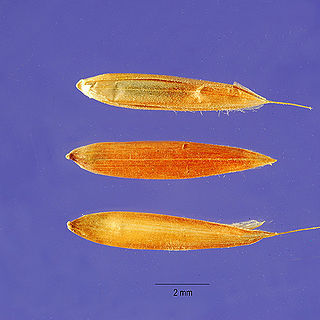Tall tufted perennial; culms 1.5–2.5 m. high.. Leaf-blades variable, up to 60 cm. long, 4–20 mm. wide, often narrowed to the midrib at the base and sometimes falsely petiolate, commonly with an external ligule (a membranous rim at junction between sheath and blade on the abaxial side).. Inflorescence of paired racemes gathered into a large leafy false panicle; racemes 4–9 cm. long; internodes and pedicels cuneate, ciliate on 1 or both sides, the pedicel ± bilobed at the tip.. Sessile spikelet 5–8 mm. long, including a shortly oblong callus ± 1 mm. long; lower glume narrowly oblong, ± flat on the back with many nerves between the lateral keels and a conspicuous median groove, glabrous, wingless; upper glume muticous or mucronate; upper lemma deeply bilobed, with an awn 10–30 mm. long.. Pedicelled spikelet narrowly elliptic, 5–8 mm. long, the lower (sometimes also the upper) glume bearing an awn 1–10 mm. long.. Fig. 180/4, p. 769.
Leaf sheaths occasionally woolly below; ligule a very short (c. 2 mm) minutely fringed membrane, the leaves often with small protuberances or a second ligule present abaxially to the ligule; laminas 20–50(80) cm × 4–22 mm, reduced to the midrib and petiole-like at the base, gradually much expanded above, folded or flat, tapering to a fine point at the apex, this often with minute dense white hairs.
Racemes in pairs, 4–10 cm long, clearly exserted from the spatheole, silvery with white hairs; peduncles longer than the racemes; internodes and pedicels clavate, ciliate with hairs c. 4 mm long on both margins, bilobed at the apex, the lobes c. 2 mm long.
Sessile spikelet 6.5–8.5 mm long; inferior glume with a shallow median groove, glabrous or with short hairs; superior glume convex on the back; superior lemma bifid in the upper 1/4; awn geniculate, 13–32 mm long; anthers 3–5 mm long, straw-coloured.
A grass that keeps growing from year to year. It forms tussocks. It grows 1.3 m high. The leaves can be woolly below. The grass has a blue-green colour. There are several varieties.
Pedicelled spikelet male, 5–7.5 mm long; inferior glume mucronate or with an awn up to 3.5 mm long.
Caespitose perennial; culms up to 350 cm high, erect, branched above, glaucous.

